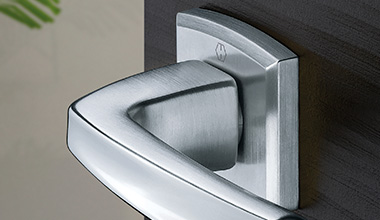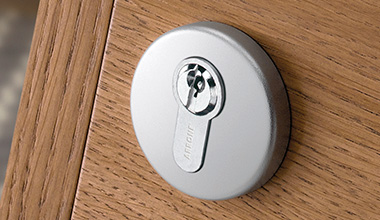HOPPE News
Fire Door Safety Week 2022: advice on maintaining fire door hardware
Monday 31st October marks the first day of Fire Door Safety Week, a whole week dedicated to raising awareness of the role that fire doors play in keeping building users safe.
In support of the week, we have asked three experts from HOPPE (UK) who have completed the Fire Door Inspection Scheme (FDIS) Diploma, to share the fire door specification and maintenance mistakes they see most often and the technical questions they get asked about inspecting and maintaining fire door hardware.
Business Development Managers:
- Ellen Mack DipGAI, MinstAI, RegAI, DipFD
- Karen Nelson DipGAI, MGAI, RegAI, DipFD
- Garrath Willshaw DipGAI, MGAI, RegAI, DipFD
Common mistakes with fire doors
“I’d say that missing hardware is the problem we see most often,” explains Ellen. “All of the ironmongery on the door has a critical role to play in making sure a fire door will work in the event of a fire, so things like damaged or absent door closers, hinges and intumescent seals will significantly impact a fire door’s performance.”
“With hinges, you often see that they are worn, which causes the door to drop and bind against the frame or other door” adds Garrath. “This then takes the minimum frame to door width past what is acceptable under BS 8214:2008, the Code of Practice for fire door assemblies.”
“BS 8214:2008 outlines the requirements for gaps around fire doors. It makes it clear that the gap between the door and the side jambs and head jamb should be no more than 4mm and no less than 2mm. The aim is for the gap to be 3mm to allow for intumescent strips activating in the event of a fire.”
“Signage is also one that people commonly make mistakes with. If it isn’t missing altogether, people can get confused over which type of mandatory signage should be on the door.”
There are three types of signs for use on fire doors:
- Fire Door Keep Shut – for self-closing doors used for passage of people.
- Fire Door Keep Locked – for doors which are locked shut and only used occasionally.
- Automatic Fire Door Keep Clear – for doors which are held open using a legal device or are swing-free but revert to self-closing when a fire alarm is activated.

Garrath says: “People propping open doors with things like door wedges is a huge problem and one that we see a lot. If a fire was to break out, the door would not shut to provide a barrier to flames, smoke and other toxic gases. We understand that in busy buildings it can make it easier for people to pass through if the fire doors are held open, but this must be done in a safe and compliant way.”
“There are two ways to do this; using an electromagnetic hold open device that is linked to a fire alarm so the door will close automatically or by using a fire door retainer.”
“Electromagnetic hold open devices are hard wired into the fire alarm system to release a door whereas fire door retainers run off batteries and are actively listening for a fire alarm sound to release.”
Fire door hardware FAQs
While ironmongery seems like a small part of a fire door, it plays an important role in how a door performs. Here are just some of the technical questions our BDMs have been asked specifically about fire door hardware (and their answers):
Q: Do I need to use 2mm intumescent hinge pads for fire doors over 30 minutes?
Ellen says: “Yes – hinges for use on 60-minute fire doors require either 1 x 2mm or 2 x 1mm intumescent hinge pads.”
Q: Does HOPPE (UK) have the fire test evidence and the declaration of performance?
Garrath says: “Fire test evidence is available upon request and Declarations of Performance (DoP) are readily available via the HOPPE website.”
Q: What type of door closer would work on a door exceeding 1100mm width?
Garrath says: “For doors exceeding a width of 1100mm, you would need a door closer that is capable of achieving power size 5 at least.”
“I’d recommend a Cam-Action door closer as it has a much smoother operating action and can easily achieve recommended operating forces as outlined in the latest accessibility recommendations of BS8300 and Approved Document M.”

Q: What certification do I need to look for when specifying hardware for FD30 or FD60 fire doors?
Karen says: “Any product that falls under a harmonised standard and is an essential piece of hardware for a fire door – hinges, door closers, latches – must carry a UKCA or CE mark. A UKCA mark is used on safety critical products in the UK and a CE mark is used in Europe. This is a legal requirement for any product that falls under a harmonised standard.”
“You should also make sure a DoP document is available for any product that carries a UKCA or CE mark.”
“This same set of products may also be covered by a third-party scheme that supports their use on fire doors. All of the ARRONE core products, such as hinges, door closers, locks and panic hardware, are covered under the Certifire scheme. The scheme assures users of the products performance, reliability and traceability of the products covered.”
Q: What intumescent should we use?
Karen says: “The requirement for intumescent must be in line with the primary evidence of the fire door it is being fitted to. Always refer to the doors test evidence to ensure you provide the correct intumescent protection.”
Would you like to know more about the ironmongery needed for fire doors? Take a look at our fire door FAQs to find out which pieces of hardware are needed, about panic and emergency exit hardware and specification considerations for refurbishment projects.




